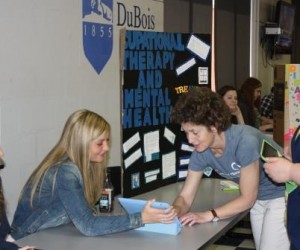
DUBOIS – Students in the Penn State DuBois Occupational Therapy Assistant (OTA) Program presented the work and research they’ve completed over the past year during an exhibition this week. Students offered demonstrations of their work in the student union, displaying therapy devices that they’ve designed and built, and presented their research using poster displays. They chose to offer the presentations during April because it is Occupational Therapy month, as designated by the American Occupational Therapy Association.
“Everything they’ve done is related to therapy that’s currently in practice in the field,” said LuAnn Demi, instructor and campus coordinator of the OTA program. She said the work students did this year helped them to learn the real-world applications for Occupational Therapy, and how it is used to help people with a wide variety of ailments. She continued, “The purpose of this research is to show the variety of places OT can be used and the variety of practice settings that there are in the field.” Demi noted that individual student research focused on areas including low vision, mental health, injuries, fall prevention, disaster relief, and more.”
“Some used traditional methods for OT, and some students have worked on implementing emerging technologies,” Demi said, noting that some students researched the use of iPad Apps in Occupational Therapy. Some apps currently available to all iPad and iPhone users are designed specifically for Occupational Therapy. They consist of games that stimulate various parts of the brain, which can be therapeutic for people with certain mental conditions.
“These apps help people with autism by working on fine motor skills,” explained student Molly Myers of Hillsdale, Indiana County, as she demonstrated a game on her iPad. Another app that Myers shared was one that can be beneficial to Occupational Therapy professionals in prescribing treatment. Using an image of the human brain, it allows the users to pin-point the functions that are controlled by each part of the brain. Myers said, “It explains what parts of the brain focus on different tasks. You just click on the part of the brain and it tells you what it does, and what diagnoses might affect each part.”
Another group of students worked with more traditional devices that would allow people who have injuries, or who are recovering from surgery to complete household tasks. Amanda Williams of Clearfield worked with her classmates to build a dog bowl outfitted with a high-standing funnel that would allow a pet owner to feed their animal without bending over. Williams said, “The funnel would be helpful for someone who has had a hip replacement, so they can’t bend past 90 degrees. So, they can feed their pet without bending down.”
Williams and her peers also designed a device that holds a book in an open position, and another one that holds a plate and silverware at an elevated point above a table top. She explained, “These are for people with neck injuries who can’t put their head down. The book stand also helps people with arthritis in their hands who want to read but have trouble holding a book.”
As the OTA students shared their research with other campus students, Demi was enthusiastic about how illustrative the presentations were of the many areas in which OT is used every day. She said of her students, “They really impressed me. They have really shown the variety of ways that OT can be used to help people in different practice settings.”